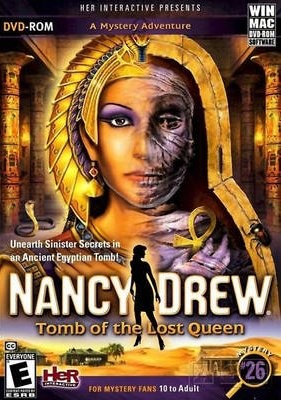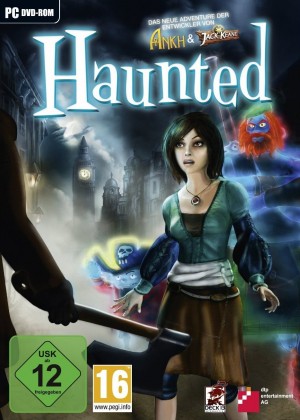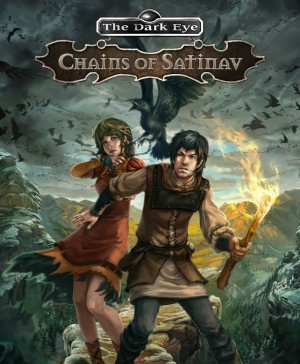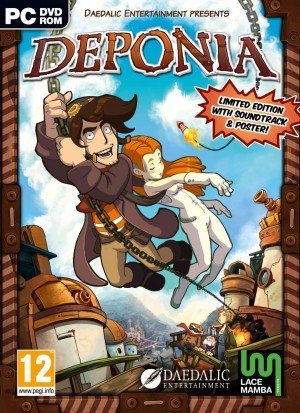Review for Resonance

Between last year's Gemini Rue and now Resonance, adventure gamers have been treated to some truly meaty science-fiction titles of late. It's a trend I'm very much okay with, though Resonance followed a rocky road to release. Lead designer Vince Twelve was known for his quirky freeware adventures Anna and What Linus Bruckman Sees When His Eyes Are Closed before announcing plans to release his first game commercially—in 2007. Five years is a long time to wait, but at last the game is finally here, no worse for wear. In fact, "worse" is not a word you'll be seeing in the rest of this review. Resonance is flippin' great.
Here's the setup: in the not-too distant future, the mysterious death of a particle physicist, Dr. Javier Morales, brings four complete strangers together: Ed, Dr. Morales's mild-mannered assistant; Anna, the doctor's niece and a (medical) doctor herself; Ray, a self-styled investigative journalist who runs a news blog; and Detective Bennet, an aging cop with a bad combover and a chip on his shoulder. At the center of everything is 'Resonance', a set of laws tied to a newly discovered subatomic particle that is capable, as new discoveries in sci-fi thrillers are wont to do, of bringing the world into a new Golden Age or destroying it altogether. Before he dies, Morales leaves clues for Anna, the only person he can truly trust, leading to a hidden vault containing the remnants of his research, and naturally the protagonists aren't the only ones searching for it. Thus the game becomes a race to track down the vault before Resonance can be misused for destruction on a worldwide scale.
The writing is suitably ambitious but wisely avoids going too "big." Despite the global reach of the plot, the game sticks to the four protagonists and their immediate situations, keeping things tightly-paced and coherent. Except for moments when the script is intentionally ambiguous, the story remains exceptionally clear, and if things ever seem a bit muddled there are helpful reminders of key plot points in the form of "long-term memories." Like any self-respecting thriller, Resonance is full of twists, revelations, and shifting alliances. Importantly, these twists never feel cheap or forced and are telegraphed with just the right amount of foreshadowing. They are surprising and satisfying, plausible without being obvious.
The characters themselves are likeable if a bit shallow, though it goes without saying that having four main characters forces the game to spread their backstories a bit thin in order to avoid hours of exposition. Anna, as the emotional core of the story, gets a deeper psychological exploration than the others, who generally stick to their archetypes. Ed is the awkward scientist, Bennet the sleazy detective, Ray the shifty reporter. They all feel believable, though, through a combination of fantastic character art and writing that is interesting without falling into the trap of being too clever for its own good. There's an undercurrent of humor in the dialogue that provides some levity to the otherwise dry and dour science-fiction conspiracy stuff, but it never overreaches by going for lame yuks. All in all, the characters do a fine job of carrying the storyline and keeping you involved, but unlike the best adventure game protagonists, they don't really stick with you once the credits roll.
At first you'll meet the four characters separately, controlling them solo in their own discrete mini-episodes, but soon fate throws them together in a desperate attempt to find Morales's murderer and prevent Resonance from falling into the wrong hands. Once the protagonists converge, the control options multiply: you can move the characters independently, switch freely between them, converse with each other, swap inventory items, and more. This kind of mechanic has been around almost as long as adventure games themselves, but it has rarely been done as well as it is here. In order to gather the necessary information to locate the vault and make sense of the clues left by Dr. Morales, you'll need to use every character at your disposal in interesting ways to do everything from bribing government employees to obtain confidential financial records to tracing mysterious phone calls to sneaking through restricted hospital levels to access private patient information.
Each character has their own observations to make about the world; point them at the same hotspot and in most cases you're going to get four different responses, some of which might reveal clues that the other characters missed. They all have access to different areas as well. Bennet, being a detective, can enter the Police Admin HQ, while Anna has the full run of the hospital, just to name the most obvious examples. This leads to a lot of puzzles that require not only inventory manipulation, but also character switching and sharing of items. It adds an intriguing new layer to already well-designed puzzles, though it can, on occasion, get a little tedious to shepherd four characters into place completely independently, only to find that one of them is blocking a hotspot that another character needs to access. But this is only a minor annoyance, and the tradeoff is well worth the depth it brings to the game.
Even without multiple characters, the puzzles would be uniformly excellent. This is not an easy game, yet every time I was about to give in to frustration I would see that I was simply looking at the situation from the wrong angle or missing a critical piece of information. Some of the puzzles seem extremely unforgiving at first, only to reveal themselves as completely achievable after some out-of-the-box thinking. And the variety of tasks ensures that you don't come to a puzzle and think, "Great. Another damn slider puzzle." You'll have to hack computers, control magnets, pinpoint locations on maps using geometry (yes, for real), and talk your way out of sticky situations.
Adding another layer of intrigue and complexity is the innovative memory system. Memories are like abstract inventory items; concepts and scraps of information that can be examined or shown to another character as a dialogue topic. Think of it like this: each character has three separate inventories—a standard inventory for items and two memory banks, one for long-term memories and one for short-term. Long-term memories are key plot points—major pieces of dialogue, backstory, or events—that are automatically added as you progress through the game. Examining them brings up a small window that plays a flashback of the memory, while using them in conversation will trigger the characters to talk about that subject. The long-term memory bank also serves as a sort of quest log and notes section where you can review important information and goals, which goes a long way in keeping you from getting lost in the complexity of the story.
Short-term memories, on the other hand, are basically hotspots from the environment that can be dragged into the short-term memory bank so that they can be referenced in dialogue. Need to ask a receptionist for access to a computer terminal in the room? Drag the terminal into the short-term memory bank and then click on it while talking to the receptionist. This works really well, simulating more abstract thought processes and forcing players to take a more active role in the dialogue rather than just interacting with everything and then waiting for dialogue options to appear that push you in the right direction.
The memory mechanic never gets boring and always teeters on the right side of the "just hard enough / too dang hard" divide. In other words, exactly what we want out of a challenging adventure game. Some of the puzzles are truly brutal; the developer has been very open about his love for Riven's unforgiving challenge level, but he also seems to understand that not everyone wants to hit a brick wall every few minutes. You'll generally able to augment the toughest puzzles with an extra item (as in the case of a literal puzzle box that can be solved as-is or with the "help" of another item that gives you an advantage) or in some cases can circumvent the puzzle altogether by simply finding another solution to the problem. There is one exception, however—a dialogue sequence near the end of the game that feels unfairly obtuse, especially compared to the plethora of subtle hints embedded in the other challenges. For a game that lasts around 9-10 hours, it seems ridiculous to spend an hour and a half of it on a single dialogue tree with seemingly endless possible fail states. But it speaks to the quality here that as soon as I passed the offending puzzle, I was right back to loving the game.
Something else worth noting is the prevalence of computer terminals in the game. There are at least four or five completely unique computer interfaces that you'll encounter and almost every one features a surprisingly fleshed-out interface. Whether you're using Ray's smartphone or a command line-only mainframe terminal, it's clear that a lot of care has gone into crafting the look and functionality of each interface. It's a small touch, but one that adds a lot, especially considering how many of the puzzles take place partially or entirely within these interfaces. The rest of the game's standard point-and-click interface is polished and intuitive—left clicking on an object will use or take it, while right-clicking will examine it. Items and memories can be dragged from their respective storage banks into the gameworld to use them on characters or hotspots, or can be dragged into a small box on the dialogue window during conversation in order to discuss them.
It's not unusual for independent games to feature retro-style graphics, so it comes as no shock that Resonance tries for a mid-'90s pixel art aesthetic. What is unusual is how successful it is. It feels more like a big-budget game from 1994 than a low-budget independent game trying to look two decades old. Backgrounds are packed with detail, and while they may not have Gemini Rue's painterly atmosphere, they're certainly nice to look at, and many of them have classy little touches like cars passing in the foreground or birds flying overhead. These add a lot of life to what would otherwise be very static environments. Variety rules the day again, with locations around Aventine City ranging from graffiti-splattered alleys to sanitized hospital hallways. The game also features a single video sequence that kicks off the action in spectacular style, featuring frantic shaky-cam news footage of destruction around the globe. It certainly makes you aware of the stakes.
The high point of the presentation is the character design and animation. Every character, playable or not, looks distinctive, with subtle touches like Bennet's bad hairstyle or the Tortoise Security owner's weird cyberpunk monocle. Better yet, there are several unique animations for each character rather than relying on generic, canned animations for everything. Characters even manage to express some emotion physically, a rarity in games with this constrained graphical style.
Most of the emotion comes through the voice acting, of course, which is quite good. Pre-release coverage has made a big deal of the casting of Logan Cunningham, better known as the narrator from Bastion, whose performance in that game made him something of a minor voice acting celebrity. As Detective Bennet he does often steal the show with his sardonic and gravelly quips, but everyone does a great job. Sarah Elmaleh as Anna is the other standout—she provides the game's heart and has the most demanding and wide-ranging performance to give. The music isn't quite as memorable, providing the appropriate atmosphere but without much zeal.
There are a few different endings, and while the decision that alters the finale only crops up at the very end of the game, it does so in a refreshingly organic way. Rather than confront you with a dialogue box with options A or B, you're presented with a specific situation to see how you work your way out of it. It's conceivable that the uninformed player might not even realize that there are multiple solutions depending on their interpretation of the story up to that point. The endings themselves aren't wildly different in their execution, but they are very different in their moral implications. These aren't merely 'good' and 'bad' endings; rather they all exist in a deliciously intriguing and tormenting moral grey area.
While many games with lengthy development periods end up disappointing, Resonance will grab you from the start, challenge you all the way through, and leave you fully satisfied by the time the credits roll. It may not have the most memorable characters or the most evocative world, but it features strong storytelling for people who value a good sci-fi yarn, and clever, devious puzzles for those who want to test their mettle in a polished and relatively lengthy package. It's even very affordable at a bargain budget price. What more can you ask for in a game?
WHERE CAN I DOWNLOAD Resonance
Resonance is available at:
We get a small commission from any game you buy through these links (except Steam).Our Verdict:
Resonance took a long time to arrive, but this meaty, challenging sci-fi thriller has unquestionably been worth the wait.


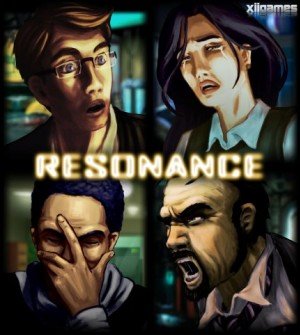
_capsule_fog__medium.png)







